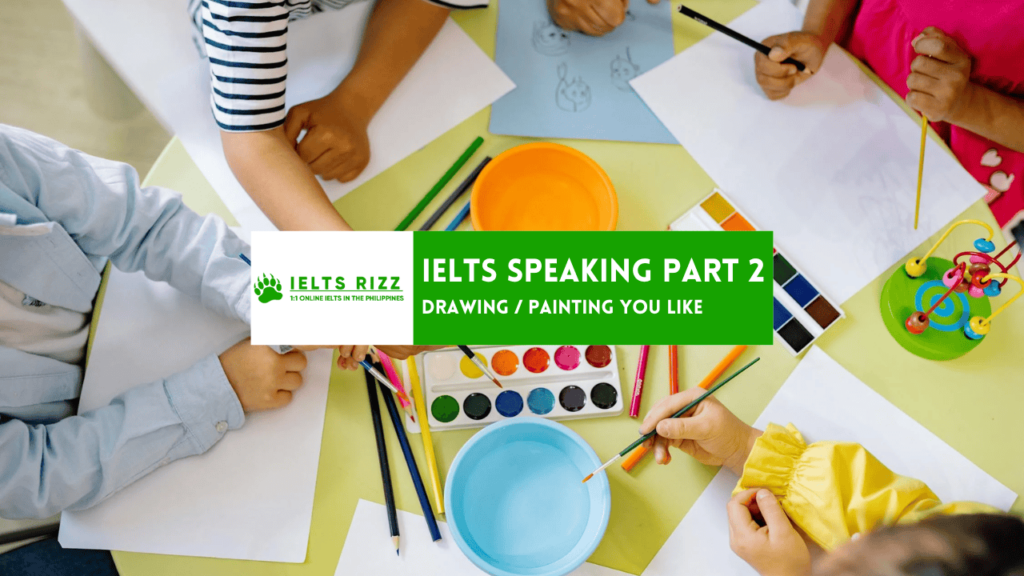
IELTS Speaking Part 2 and 3 : Describe a Drawing
IELTS Speaking Part 2 – Describe a drawing/painting that you like
Describe a drawing/painting that you like
You should say:
- When you first saw this painting
- What the painting is about
- Who drew/painted it
- And explain why you like this drawing/painting
Version 1
That drawing holds a special place in my heart. It’s a piece I created when I was younger, and stumbling upon it after so many years brought back a flood of memories. I actually framed it because it’s more than just a drawing to me—it’s a snapshot of my childhood. The drawing depicts my family and the house we dreamed of at the time. It started as a simple doodle, but I filled it in with crayon colors, capturing the innocence and simplicity of my younger self.
In the painting, my parents, my older sister, and I are portrayed alongside a two-story house with a red car—a detail I particularly liked. I had hoped for a room like the one in the drawing as I got older, but unfortunately, that dream didn’t fully materialize. As time passed, our family dynamic changed, and the envisioned life depicted in the drawing evolved into a distant memory. Despite this, the painting serves as a poignant reminder of my childhood aspirations and the connections to my family.
Seeing this drawing now evokes a mix of emotions for me. It brings forth both sadness and happiness, along with a tinge of nostalgia. I reflect on how differently I viewed the world back then, believing in the straightforward path to a beautiful family and home through hard work. However, adulthood has shown me the complexities and challenges of life.
Gazing at the drawing transports me back to those cherished moments spent with my family around the table. It’s a bittersweet reminder of the past, and I find myself longing for those simpler times. There are instances when tears well up in my eyes as I confront the reality of what I’ve lost. Yet, simultaneously, the drawing serves as a beacon of the dreams and ideals I held dear as a young, hopeful individual.
Now, with my own family, I often find myself reminiscing about my youthful aspirations and the opportunities that slipped away. The drawing remains a tangible link to my past, filled with dreams and youthful optimism. Its mere existence sends shivers down my spine, serving as a testament to the journey I’ve undertaken from innocence to experience.
IELTS Speaking Part 3 – Describe a drawing/painting that you like
1. What are the differences between painting and drawing?
Drawing requires a keen understanding of perspective and detail, typically done with pencils. Artists focus on angles and precision to convey their vision accurately. In contrast, painting emphasizes color and shading to depict light and create depth. Artists like Bob Ross showcase the intricate process of using colors to represent light, demonstrating the complexity of painting techniques.
2. Why do some people keep a painting for a long time?
Beyond the aesthetic appeal, paintings hold artistic value that can appreciate over time. Collectors may invest in early works of struggling artists, anticipating their rise to fame, and subsequent increase in the painting’s value. Additionally, owning valuable artwork can serve as a financial investment, with the potential for significant returns if the painting gains popularity and demand among art enthusiasts.
3. How does building style affect people’s lives?
The style of buildings significantly impacts people’s daily lives. Factors such as lighting, ventilation, and spacing affect mood, privacy, and overall well-being. Buildings with ample natural light and ventilation contribute to a more cheerful atmosphere compared to those lacking such amenities. Additionally, the layout and density of buildings can influence community dynamics and even crime rates, highlighting the profound impact of building style on people’s lives.
4. Should children learn to draw and paint? Why?
Yes, children should learn to draw and paint as it provides them with a means of expressing their emotions and creativity. Artistic expression fosters communication and allows children to articulate their feelings, even when verbal communication may be challenging for them. Encouraging children to explore art from a young age nurtures their imagination and self-confidence, enabling them to develop essential skills for personal and emotional growth.
5. How do young people share arts with others?
Young people often share their art through social media platforms, showcasing their creations to a wide audience. Additionally, more traditional methods, such as displaying artwork in homes or community spaces, remain popular. For instance, in the United States, it’s common for families to display children’s artwork on refrigerators, providing a tangible way to share and appreciate artistic expression within the household.
6. Do you think the objects we use in our daily lives should be beautifully designed?
Yes, aesthetically pleasing design enhances the user experience and adds value to everyday objects. Whether it’s the sleek design of a car or the intricate details of household appliances, beauty in design elevates functionality and enhances user satisfaction. From smartphones to coffee cups, thoughtful design elements enhance the overall enjoyment and usability of everyday items, reflecting the importance of beauty in design across various aspects of daily life.
Check Placement Test for Speaking
Please visit the website Educatorian to find suggested answers for IELTS speaking questions. Additionally, I recommend checking out Ian’s website for further information.
请访问Educatorian网站,找到雅思口语问题的建议答案。此外,我建议查看伊恩的个人网站以了解更多信息。

Ian Tanpiuco – Virtual Assistant, Educatorian, and IELTS Rizz Tutor. Ian’s goal is to enhance his students’ IELTS scores through a comprehensive curriculum that focuses on understanding rather than mere memorization.

